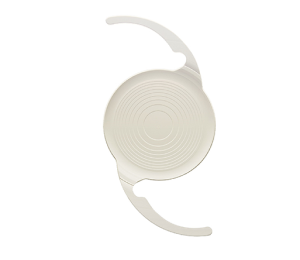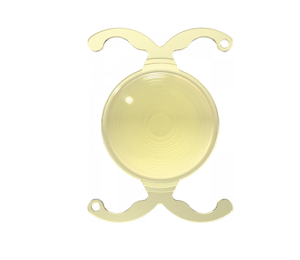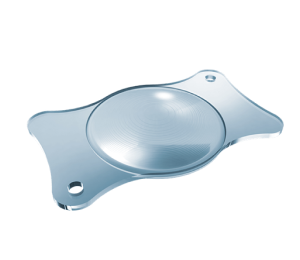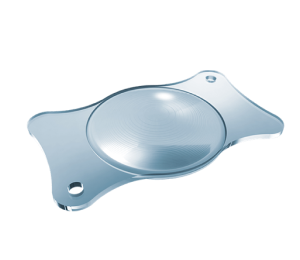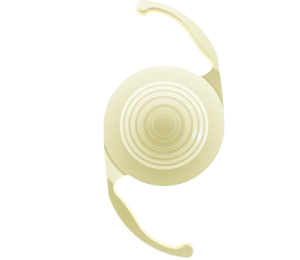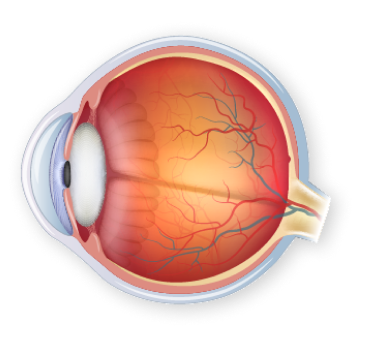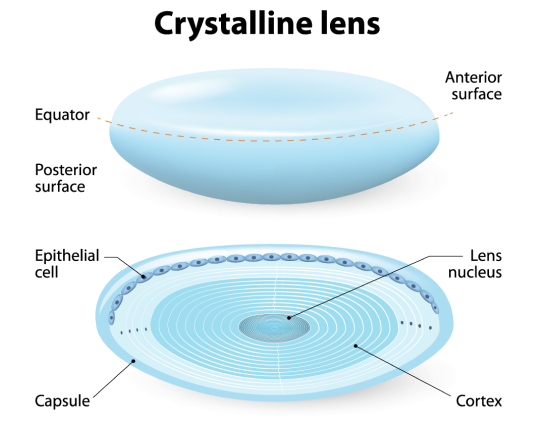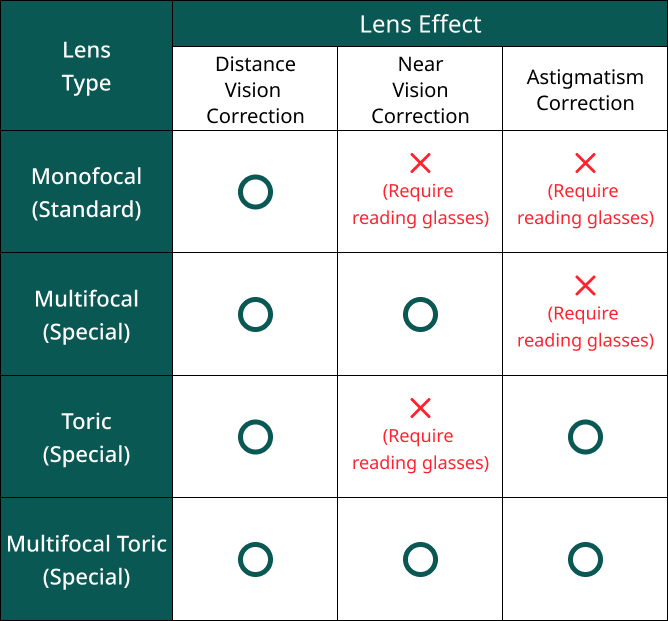-
Q If you are experiencing significant discomfort due
to presbyopia, is there a good surgical method available?
When deciding on surgery for presbyopia, the most important factor to consider is the cause of presbyopia. In people in their 40s and 50s, the most common cause of presbyopia is a decrease in the eye's focusing ability without lens opacification. Since there is no lens opacity, vision can be corrected with reading glasses, and in such cases, surgery is not recommended.
If you have severe hyperopia causing presbyopia symptoms at an early age, or if you have severe myopia where you cannot see well at a distance without glasses and cannot see up close with glasses due to presbyopia, surgery to appropriately correct hyperopia or myopia can help alleviate presbyopia symptoms.
In individuals over 60, presbyopia is often accompanied by cataracts. If vision remains blurry and uncomfortable even with reading glasses, cataract surgery should be considered. When performing cataract surgery, inserting a multifocal intraocular lens can correct both near and distance vision without the need for reading glasses, thereby also addressing presbyopia.
-
Q What is presbyopia cataract surgery?
Presbyopia cataract surgery involves inserting a multifocal intraocular lens during cataract surgery. The procedure includes making an incision to open the lens capsule, removing the cloudy lens nucleus and cortex, and then inserting the multifocal intraocular lens into the lens capsule. The process is not significantly different from cataract surgery with a monofocal intraocular lens, so it is a procedure that experienced ophthalmologists who have been performing cataract surgeries for a long time can easily perform.
-
Q I went to hospital because of presbyopia and have been recommended
to do lens implantation surgery. What is lens implantation surgery?
If the eye clinic recommended lens implantation surgery for your presbyopia, it’s important to clarify what type of lens implantation they are referring to. Some clinics use the term "lens implantation" to describe cataract surgery with multifocal lenses, so caution is needed to avoid confusion.
Generally, lens implantation surgery refers to a vision correction procedure where a lens is inserted between the natural lens of the eye and the iris to correct myopia or astigmatism. This procedure is usually performed on younger patients, typically in their 20s or 30s.
In contrast, cataract surgery involves removing the natural lens (including its cortex and nucleus) and replacing it with a multifocal intraocular lens. This type of surgery is different from lens implantation surgery because it involves removing the natural lens and replacing it with an artificial one.
If you are still in your younger years and your natural lens is clear but experiencing presbyopia, opting for lens extraction and multifocal intraocular lens implantation might mean replacing your original, clearer lens with an artificial lens that has lower light transmission. This could lead to various discomforts and, although rare, potential complications years later.
-
Q Are multifocal intraocular lenses always better than monofocal lenses?
Not necessarily. Monofocal lenses can provide better brightness and sharpness when viewing a single distance, such as far vision. Multifocal intraocular lenses offer the advantage of being able to see up close without needing reading glasses, but they may cause some reduction in vision quality at night or light scatter, although adaptation usually reduces these issues over time.
Most daily activities involve near vision tasks like using smartphones, computers, reading documents, and kitchen work. As a result, some people find that monofocal lenses do not adequately address presbyopia and may feel considerable discomfort.
Continuous-focus lenses, while not as strong in near vision as diffractive multifocal lenses, offer better brightness and clarity for distance vision. Choosing the appropriate intraocular lens is crucial, so it's important to consider your specific eye condition and needs and discuss with your ophthalmologist to make a well-informed decision.
-
Q When should cataract surgery be performed?
People often wonder when they should undergo cataract surgery. The most important factors to consider are how well your vision can be corrected with glasses, how much light is obstructed by the cataract as it reflects off the retina, and whether the cloudiness in your vision is causing enough discomfort in your daily life. These considerations help determine the appropriate timing for the surgery.
-
Q If cataract surgery is delayed, could it lead to complications like glaucoma?
If cataracts are not causing significant discomfort or impairing daily life, there's no immediate need to worry about complications like glaucoma simply due to the delay in surgery. Most cases of cataracts do not lead to complications such as glaucoma or uveitis unless they are very advanced or rare conditions, such as lens syndrome or extremely advanced cataracts that approach near-total blindness. Various factors can cause vision impairment, including simple presbyopia, which is more common than cataracts. However, conditions like glaucoma or macular degeneration can occur, so it's important to get an accurate diagnosis first.
-
Q How long does an artificial lens last after cataract surgery?
An artificial lens typically does not need to be replaced unless there is a specific problem.
It is designed to last for the long term.
-
Q Is it possible to have cataract surgery again if needed?
Yes, it is possible to undergo cataract surgery again if needed. Replacing an artificial lens is generally not difficult. However, if more than six months have passed since the initial cataract surgery, the artificial lens may be adhered to the lens capsule. In such cases, the adhesion must be separated, the old lens removed, and a new lens inserted. This process may require precise adjustments to ensure proper fitting.
-
Q Which cataracts are difficult to operate on?
Cataracts can be challenging to operate on in several situations:
When cataracts are very advanced.
If the pupil cannot dilate adequately.
In cases where cataracts are complicated by uveitis or closed-angle glaucoma.
If there is weakness in the zonules (the fibers that hold the lens in place), leading to lens dislocation.
When there is lens capsule syndrome.
In patients older than 80 years of age.
If the patient cannot cooperate during the procedure under topical anesthesia.
-
Q I went back to hospital 6 months after surgery and they told me I should do laser treatment for aftercataract. Is it possible to develop posterior capsule opacification (PCO) so soon after cataract surgery?
Yes, posterior capsule opacification (PCO) can occur within a short time after cataract surgery. PCO, or aftercataract, happens when the capsule behind the lens becomes cloudy. This is more likely to occur in younger patients and can be delayed if the lens capsule is thoroughly cleaned during the surgery—a process known as polishing. Polishing the capsule requires great skill and precision, as an unskilled operator might accidentally rupture the capsule, making the procedure more complex.
-
Q Is laser cataract surgery definitely better?
The laser cataract surgery equipment currently available has some drawbacks, so it cannot be said to be unconditionally better. Laser cataract surgery cannot handle the entire process of cataract surgery; rather, it can only assist in certain parts of the procedure, such as corneal incision, anterior capsulotomy (removing a circular portion of the front part of the lens capsule), and fragmentation of the lens nucleus and cortex. Many hospitals use lasers primarily for anterior capsulotomy. While this part of the procedure can be challenging for surgeons without much experience in cataract surgery, it is a straightforward process for skilled surgeons. Therefore, most specialized ophthalmologists who have been performing cataract surgery for a long time do not necessarily need laser cataract surgery equipment.
The success of cataract surgery depends not only on the anterior capsulotomy but also on other critical steps, such as polishing (cleaning the lens capsule), which cannot be performed with a laser. All these steps must be done well to ensure good vision and long-term stability. Simply using a laser for part of the surgery does not guarantee better results. Moreover, if there is corneal opacity or if the cataract is advanced, laser surgery may not be possible. There is also a risk of complications, such as the device used to hold the eye in place under negative pressure becoming dislodged. Due to these factors, the use of laser cataract surgery has been declining recently.
-
Q Is the surgical procedure different when implanting a
monofocal intraocular lens (IOL) versus a multifocal IOL?
The surgical process is not significantly different between the two types, but there are some important considerations with multifocal IOLs. The center of the multifocal lens must align well with the visual axis, and any astigmatism should be corrected simultaneously. Even a small amount of posterior capsular opacification (aftercataract) can cause discomfort with a multifocal IOL, so careful polishing of the lens capsule is necessary to maximize the lens’s multifocal function and maintain long-lasting vision. This requires a more delicate and precise surgery compared to monofocal IOL implantation.











